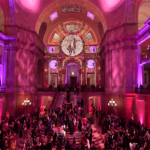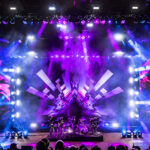December saw eSports come to Boston in a big way when the Wang Theatre at the Boch Center hosted the Boston Major tournament. The competition for Valve Corporation’s multiplayer online battle arena Dota 2 video game took place Dec. 7-10. Along with the live audience in the theatre, the four days—with up to 12 hours a day play—was followed globally via the video game live-streaming platform Twitch.tv and through a variety of international television outlets including ESPN in the U.S.
Dota 2 has an active competitive following, with teams from across the world playing professionally in leagues and tournaments. The Boston Major elimination tournaments were between two teams of five players each, battling it out for a combined prize purse that totaled $3 million. Broadcasts of professional matches, like the Boston Major, streamed live and simulcast on TV, rival tradition sports by getting peak viewership in the millions. eSports is a big business and they don’t scrimp on production values, making them a fast growing new market segment for the live entertainment production industry.

For the Boston Major, tournament producer PGL called on Warwick, RI-based East Coast Lighting & Production Services, Inc. (ECLPS) to provide the production support for both the tournament at the Wang as well as the preliminary rounds at the Westin Copley Place Hotel.
“We provided all of the lighting, audio, rigging, video projectors, monitors, effects and all of the broadcast cameras,” says Nathan Almeida, Production Coordinator with ECLPS. “Other than the LED video walls and media servers, everything went through us. PGL wanted us to act as a one-stop-shop and source all of the technical requirements. PGL produces events all around the world and for the stage and lighting design they brought in StarLadder, a company based in Kiev, Russia. So we fulfilled the specs from StarLadder’s designers and technicians as well as supplying crewing and logistics support.”

Lights, Cameras, Action!
One of the first items that Almeida sourced were the cameras for the I-Mag and broadcast, which had explicit requirements in regard to the output that was required to properly show the real-time game play. “The biggest challenge was finding the proper cameras for broadcasting the game, since their highest priority were for cameras that could shoot 1080p at 60 frames per second (FPS),” he continues. “Cameras capable of 60FPS are not that easy to find; most everybody stocks cameras that shoot 30 FPS. We worked with Clark Media out of Bethlehem, PA to provide the cameras and processing. They had just recently purchased Panasonic AK-UC3000 cameras that were capable of handling 60FPS. In fact, they bought four more for a total of 11. All of which were used at the Boston Major.”
The media servers for the project were provided by Miami, FL-based DMD S7udios with Scott Chmielewski serving as DMD S7udios project manager and Green Hippo’s Cory Froke as the media server engineer for this project. “The media servers were there for playback of the high-resolution content, as well as for cleanly scaling the HD broadcast feed up to the resolution of the stage screens,” explains Froke. “The LED product specified for this project had some very unique mapping limitations, so there was a lot of re-mapping that had to be done within the VideoMapper component to chop things up to work within those limitations. We took the game feed into the servers via 3GSDI and then used the servers to switch between game feed, program and content. Scott supplied his new Green Hippo servers—two Boreal DisplayPort, each with two 3GSDI Capture Cards and one Boreal DVI-DL with two 3GSDI Capture Cards. The Boreals are part of the V4 line, and Scott has the first two Boreal DisplayPort units in the United States.”
Discussing the 60FPS playback requirement Froke continues, “PGL was really specific; they wanted to do full 60FPS capture so the game didn’t stutter or pause. It ended up working fantastically because we could get 60 frames in and 60 frames out with under a frame and half latency, even with all the extensive re-mapping. The game play in Dota 2 is extremely fast, so you would definitely notice if it wasn’t running at full 60FPS. I understand why they insisted on the 60FPS. Most of the bigger games are definitely all about 1080p60; and a lot of them are trying to go even higher resolution. We can actually do 4K capture at 60FPS right now, so that would be fine for us.”
All of the video switching, which was from PGL, was via a Blackmagic Design ATEM Television Studio system. With the player’s game pods upstage on the Wang Theatre’s stage, the large LED screen cut off the view from the upper balcony. A 40-by-23-foot projection screen was flown in the house and the ECLPS video crew used two Barco HDF-W30 Flex projectors converged to provide IMAG playback for the audience members in the upper balconies.
The lighting package included more than 500 units, including moving lights, scenic lighting, key lighting for the game analyst and host areas. The package, which was controlled via three High End Systems’ full sized Hog 4’s consisted of a mix of fixtures including Clay Paky Sharpy and B-Eye K20s, Elation 5×5 CuePix, TVL3000-II and Color Chorus 48s, Philips Color Kinetics ColorBlast 12s, Robe Cyc FX/8s, Eurolite 2 Lite Moles and KR10 Strips and Martin Aura XBs, Quantum Wash, MAC 101, MAC Viper Profile and MAC 2000 Wash XB units.

The team from ECLPS supported a small studio for the game analyst’s desk backstage left. “We set up a whole flown truss structure with curtains and lights for the analysts,” comments Almeida. “Mystic Scenic, a local Massachusetts company built the analyst desk along with all of the custom scenery, the light up staircase, even laid down a high gloss black floor for the entire set. In addition to Kino Flos for the analyst and interview areas, we also used 32 of the Elation TVL3000-II DW LED fixtures at the hotel and on the analyst set for keylighting. They have an adjustable color temperature from 2,900—5,600K, even though we shot everything at 5,600K for this project. They are a good little unit for the price point and only draw 70W at full so I could put a lot of them on one circuit.” There was also rigging support from ShowRig for this event.
Almeida gives credit to his vendors and everyone at ECLPS, both on site and back at the shop, who worked together to realize this fast turnaround project. He got the designs in the first week of November and didn’t have a lot of time to coordinate all the different vendors. “I’d also like to thank the IATSE Local 11 crew. They’re great, as always. They and the staff at the Wang, led by their production manager Chris Bullock, absolutely killed it. It was a true team effort by everyone. You know, it was a cool thing to see another way that theatrical production can be used to support a very different kind of project.”
Boston Major Equipment and Crew List
Lighting Equipment Provided by ECLPS
- 95 Clay Paky Sharpy
- 53 Clay Paky B-Eye K20
- 56 Martin Professional Aura XB
- 53 Martin Professional Quantum Wash
- 10 Martin Professional Mac 101
- 7 Martin Professional Mac Viper Profile
- 20 Martin Professional Mac 2000 Wash XB
- 32 Martin Professional Atomic 3000 Strobe
- 32 Eurolite 2 Lite Mole
- 24 Eurolite KR10 Strip
- 14 Elation Professional 5×5 CuePix
- 32 Elation Professional TVL3000-II DW TV Studio Light
- 12 Elation Professional Color Chorus 48
- 12 Philips Color Kinetics ColorBlast 12
- 12 Robe Cyc FX/8
- 3 High End Systems Hog 4, Full Size Consoles
- 4 High End Systems Hog DP8000 Processors
- 2 ReelFX DF50 Hazers
- 2 High End Systems F100 Foggers
Video Equipment
All Video Cameras and Processing were supplied by ECLPS in conjunction with Clark Media
- 11 Panasonic AK-UC3000 2/3” 4K Camera and Accessories
- 1 Blackmagic Designs ATEM Television Studio Switcher System
- 16 Sharp Aquos 60” Edge-Lit Monitors with Stands
- 2 Barco HDF-W30 Flex Projectors
Media Servers
- All Media Servers and Labor were supplied by DMD S7udio
- 2 Green Hippo Boreal DP with 2x 3GSDI Capture Card
- 1 Green Hippo Boreal DVI-DL with 2x 3GSDI Capture Card
Media Server Crew
- Project Manager: Scott Chmielewski, DMD S7udios
- Media Server Engineer: Cory Froke, Green Hippo
- All Rigging was supplied by ECLPS in conjunction with SGPS: ShowRig
- Head Rigger: Steve Robinson, SGPS: ShowRig
- Assistant Head Rigger: Bianca Mauro, SGPS: ShowRig
All Audio was supplied by ECLPS in conjunction with Bergstein Music
All Custom Scenery was provided by Mystic Scenic
ECLPS Crew
- Production Coordinator: Nathan Almeida
- Master Electrician/Lighting Crew Chief: Chris Griffin
- Assistant Master Electrician/Crew Chief: Joseph Nieuwendyk
- Lighting Technicians: Bill Sheldon, Lee Figueroa, Ed Boulet, Kyle Mello, Jenel Barry, Alicia Colantonio, Sean Fisher
- Head ECLPS Video Technician: Vanio Tavares
- Head ECLPS Audio Technician: Matty Colon
- Effects: Shane Martz
Boch Center Personnel
- Boch Center Production Manager: Chris Bullock
- Boch Center, Wang Theatre Master Carpenter: Russell Jones
- Boch Center, Wang Theatre Master Electrician: James Paulson


